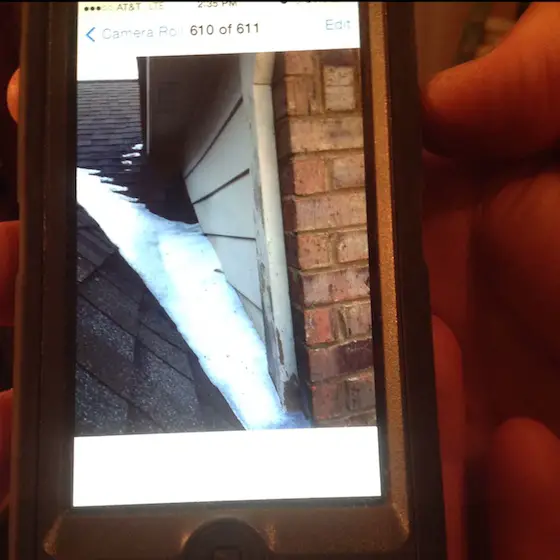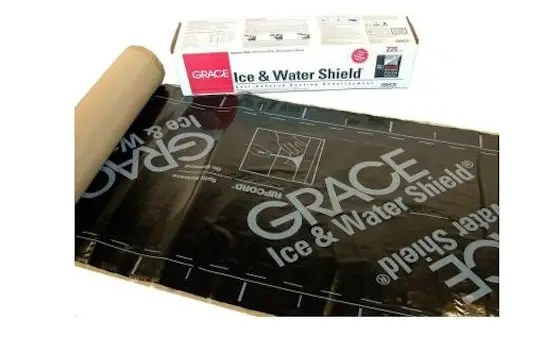Preventing Ice Dams – Two Ways To Do It

Ice Dam | Here's a photo of the ice dam at Karen's house. This is a photo of a photo. You're probably looking at the roofer's cell phone screen. Photo credit: Anonymous roofer and Karen Bloom
Prevent Ice Dams? Keep Snow Off Your Roof
Here's the truth about ice dams. They are always going to form unless they have no food or fuel. This means you have to remove the snow from your roof.
This is not practical at all. I know as I have lots of roof in New Hampshire.
Related Link
ACCKK! STOP the Ice on my Gutter Guards!
Prevent Leaks From Ice Dams? Yes, That's Easy To Stop
You can stop leaks from ice dams by installing amazing membranes under roofing materials. These membranes stick to the roof sheathing and seal around the shafts of the nails. They are miracle roofing products and I have them on my home. Here's a video of the Grace Ice and Water Shield I have on my house:
Ice dams on roofs can cause water to pour down the inside of exterior walls and gush through ceilings. In almost all instances, all you can do is try to collect the water and call your insurance agent. There's no magical valve you can run and turn off to stop the flow of water. The water continues to flow until the snow and ice melts or the outside temperatures drop enough to re-freeze the liquid water that is backing up under your roofing materials.

I covered the ENTIRE roof of my New Hampshire house with Grace Ice and Water Shield. I never have to worry about a roof leak - EVER. CLICK on the PHOTO to have Grace delivered to your home in days.
How Many Homeowners Get Ice Dam Leaks?
This unfortunate scenario happens to thousands of homeowners each winter. It happened to my next door neighbor eight years ago, just 18 months after I had installed a gorgeous new kitchen for her. The tears in her eyes were flowing as fast as the snow melt dripping through her kitchen lights as she saw her warm and cozy kitchen turn into a rain forest in the middle of winter. Her ice dam leak had nothing to do with my work as the ice dam formed up on the original house roof 12 feet above the kitchen I recreated.
CLICK or TAP HERE to get FREE BIDS from local roofers to install Grace Ice and Water Shield.
When is the Best Time to Stop Ice Dam Leaks?
The best time to stop ice dam leaks is when you're installing a new roof or building a new home.
When building a new home you have a golden opportunity to stop ice dam leaks from making you a statistic. Your builder, rough carpenter and roofer can team up to add small innocuous options to your home that are hidden from view but go a long way to stop water from entering the finished rooms of your new home.
Does Water Backup Under Overlapping Shingles?
Water does back up under shingles if it can't drain by gravity to the ground.
To stop leaks caused by ice dams, it helps to understand how the snow-melt water can leak into the same roof surface that effectively stops rain drops in even the most violent thunderstorm. Study a typical sloped residential roof surface and you will see overlapping layers of asphalt shingles, slate, tile, wood shakes or some other roofing material. So long as water moves down the roof, this overlapping system works. But if water travels backwards up under the overlapping materials, water begins to work its way inside.
Why do ice dams form?
Ice dams form on roofs when the chilled snow melt water flows down the roof surface and re-freezes as it contacts cold shingle, gutter, and flashing surfaces whose temperature is below freezing. As more water flows down the roof the ice buildup gets higher and higher. In some instances the ice dam can grow to be one foot or higher. Liquid water builds up behind the dam and that which does not re-freeze often leaks into your home.
Ice dams can form for all sorts of reasons. Where the roof passes over an exterior wall, attic insulation is often thin. Heat can escape from the house and help to melt snow pack that is up on a roof. Ice dams can even form in the center of a roof if conditions are just right.
What is the Easiest Material to Stop Ice Dam Leaks?
The easiest material to install to prevent water from entering your home is an ice dam membrane that is applied directly to the lower edge of the wood surface of the roof before the shingles or roofing material is installed. The membranes should also be installed at roof valley locations, places where the roof might change pitches and around all penetrations such as skylights, plumbing vents and other roof vents.
These special membranes often contain rubberized asphalts and an inner synthetic membrane that work to seal around all nails that penetrate this membrane as the finish roof is installed. The water from an ice dam will still back up under the roofing materials, but it can't get through the membrane and into your home.
Will a Higher Heel Height on Rafters Help Prevent Ice Dam Leaks?
Yes, increased heel height will help prevent ice dam leaks. This extra height allows for thicker insulation at the corner of the ceiling next to an exterior wall.
Your builder and rough carpenter can help as well by increasing the heel height of the roof rafters or trusses where they pass over exterior walls. A truss or rafter with a high heel allows the insulation contractor to install more insulation without blocking the important flow-through ventilation space between the soffits and attic area. This added insulation helps to stop heat transfer that melts snow. You can also add reflective radiant barrier chips on top of your insulation to stop the flow of heat through the insulation.
Will Larger Overhangs Help Prevent Leaks?
More generous roof overhangs also are a great preventative measure to fight ice dam leaks. The ice dams form out and away from the house and any water that does backup often just drips through the exterior soffit instead of the inside of your home.
Remember, you can't stop ice dams but your builder can do many things to prevent the leaks. You can stop water that accumulates behind these winter menaces from entering your home. Discuss all of your options with your builder before the foundation is poured.
CLICK or TAP HERE to get FREE BIDS from local roofers to install Grace Ice and Water Shield.
Column NH026
One Response to Preventing Ice Dams – Two Ways To Do It